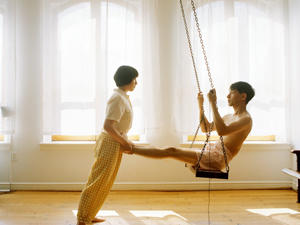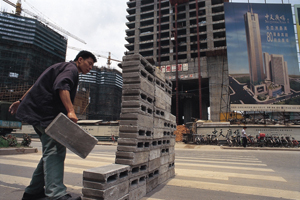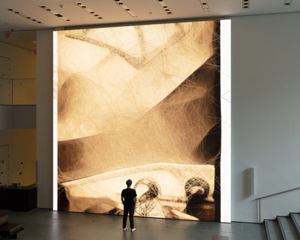Virtual Gates
John Haberin New York City
Asian New Media: Mirror Image and Visionary Legacies
Refik Anadol
More than a decade before the fall of the Berlin Wall, a world power opened its doors. Starting in 1978, two years after the death of Chairman Mao, Deng Xiaoping's "open-door policy" welcomed foreign capital into Communist China, and the ba ling hou (or post-1980s) generation grew up knowing nothing else. Now seven of its members take that experience to Asia Society for "Mirror Image."
While waiting for the elevator, you can see the sky—not the view behind you, above Park Avenue, but Yoko Ono's Sky TV. Although a gift to the museum from Harold J. and Ruth Newman, it is not formally a part of "Visionary Legacies," a tribute to Hal Newman and his collection. It was visionary all the same, of a world lost in the clouds, the actual sky in 1966, and a new medium for art. And one can watch that medium emerge in real time where one might not expect it.  Maybe you associate video with the Internet, the space of contemporary artists in "Mirror Image," but it has a longer history in Asian and Asian American art. As for the western edge of the east, Refik Anadol sees the Museum of Modern Art in his machine dreams.
Maybe you associate video with the Internet, the space of contemporary artists in "Mirror Image," but it has a longer history in Asian and Asian American art. As for the western edge of the east, Refik Anadol sees the Museum of Modern Art in his machine dreams.
Through closed doors
For the curators, Barbara Pollack with Hongzheng Han, the artists in "Mirror Image" bring with them a boundless optimism. Contemporary Asian art need no longer take a stance between "the local and the global" or "the spiritual and the material," and neither Chinese nor Western tradition is much in evidence. "East and West," the show proclaims, "are now so seamlessly merged into a third identity not particularly rooted in either region." None of the artists have left China to pursue their career, because they are just fine where they, but where is that? Art as a mirror onto society or nature is an old metaphor, but whatever is reflected in their mirror? Tianzhuo Chen shows a young woman leaning toward her mirror image with wonder and longing, but are they left with only themselves?
Can they share in the optimism, like the Korean video in "Only the Young" at the Guggenheim or the artists in "Signals" at MoMA? They seem none too sure. Cui Jie paints two towers, Shanghai Broadcasting and Belgrade's Western City Gate. Only their bright, flat colors relieve the faceless mass of Western and Asian architecture. TikTok posts of soap operas, from Tao Hui, leave behind inviting stills of silent landscapes—all the lusher for printing on aluminum. But is there a place to rest or to stand?
Deng and his successors seem unlikely advocates of open doors, only starting with their western suits and studied reserve. He brought a top-down structure to global markets, and the next generation grew up with forced relocation to cities and a one-child policy as well. Now more than ever, with demands on Hong Kong and a lockdown in Shanghai, and threats to Taiwan, those doors seem about to shut. If anything, the artists must see through doors, think of cities as network hubs, and treat their work as their favored child. Miao Ying calls the "Chinternet" and her smartphone her home, like Meg Lipke. It is certainly her studio, for a cascade of warrior princesses and tumbling colors.
That still counts as optimism, like that of Tuan Andrew Nguyen at the New Museum, but is it futurism or nostalgia? She describes her contribution Surplus intelligence and her Pilgrimage into Walden (a tribute as much to the planned community of B. F. Skinner's Walden 2 as to Henry David Thoreau). Liu Shiyuan collects images from all over the Internet and wherever else. Chen's shot of a woman falls within Trance, video of a twelve-hour performance. It claims the influence of Buddhism, Susan Sontag, and William Blake, but with little time for reflection on innocence or experience. Its rock soundtrack could well induce a trance.
It is a quiet, tentative optimism, for all the vigor and the noise. As the concurrent show of a donor's collection makes clear, new media has been around a while now, but not everything here is virtual. The one-named Nabuqi sets out a living room without furniture—plants with nowhere to stand but the rug and drapes covering everything but a light box, for a photo of the Parthenon. It embodies warmth and homelessness, in neither East nor West. What does that leave? The scare quotes and pigeon English of its title, How to Be "Good Life," are surely deliberate.
One might see the entire generation as an experiment, and Pixy Liao speaks of exploring "experimental relationships." Her photos of largely naked bodies, some almost abstracted, include I Push You and You Push Me. Capitalism and Communism alike may have run out of promises. Whether they can give way to a third identity is up to art. In Franz Kafka's "Before the Law," a man waits a lifetime to pass through an open door. At the end, says the gatekeeper, "this door was intended only for you, and now I am going to shut it."
Just across the street
You may not know Yoko Ono from video, but there she was from the start. It may remind you just how radical her work was. Even if you see it as a mere retread of Andy Warhol and his Empire State Building in real time, she had moved from film to TV. She also naturalized his darker and more demanding vision of a New York landmark, to a sky that anyone could see. One can still head outside for much the same sky, give or take her pink and white clouds. Apparently she had a weakness for sweetness and light years before she discovered John Lennon and world peace.
 Go ahead and blame the pioneer of video art, Nam June Paik. Even then, art's future came with a degree of nostalgia and a smile. He built the most monstrous of his robots from ten antique TVs, an antique radio set, and a Korean print block. Their screens flicker as it raises in greeting its robotic arm. Just do not blame him for Tromarama, an Indonesian collective that adds cartoon lips to singing handbags. It is not Paik's fault that some art is better suited for social media and children.
Go ahead and blame the pioneer of video art, Nam June Paik. Even then, art's future came with a degree of nostalgia and a smile. He built the most monstrous of his robots from ten antique TVs, an antique radio set, and a Korean print block. Their screens flicker as it raises in greeting its robotic arm. Just do not blame him for Tromarama, an Indonesian collective that adds cartoon lips to singing handbags. It is not Paik's fault that some art is better suited for social media and children.
Has anime ruined Asian art once and for all, including painting? Things are not quite that bad. Akino Kondoh, at home in Japan and New York, thinks of herself as a manga artist, but her Evening Traveling borrows the black of a classic woodcut. Cao Fei and her alter ego, China Tracy, live in the virtual world of iMirror. Yet it seems real enough, and that i could be me. "In the virtual land," she writes, "we are not what we originally are, and yet we remain unchanged."
The nine artists, most from the last fifteen years, often seem at home in the past, but with a digital spin. The silhouettes in Seven Intellectuals in a Bamboo Forest, by Yang Fudong, climb wondrous peaks against a shimmering haze. And yet their settings keep shifting, in segments constructed over four years, so that one may never know their place and time. Mami Kosemura adds European motifs to Flowering Plants of the Four Seasons—red flowers on green stems with the look of Japanese screen painting on weathered paper. In reality, these are time-lapse photos, with a bow to Eadweard Muybridge in the 1870s. Time itself becomes her subject.
These are dream shadows, like an elephant behind a window pane for Hiraki Sawa in Japan and London. His animal procession follows the arch of an empty apartment like figures in an ornamental clock. Jun Nguyen-Hatsushiba in Japan fills a room with a "memorial project" for Vietnam—based on a cyclo, the modern version of a rickshaw, itself already out of date. Laborers pedal underwater across a rocky seafloor. They toil For the Courageous, the Curious, and the Cowards. It takes just over half an hour. Darkness is never out of reach, but neither is endurance.
Lin Yilin, based in China and New York, shoots in color, too. Yet she also returns to real time and a real city, like Ono herself. Safely Maneuvering Across Lin He Road presents a busy intersection, where the traffic lights seem never to change and traffic never lets up. Still, a man manages to take down a cinder-block wall and reassemble it across the street. Like his shadowy or digital counterparts in other work, he finds a kind of peace.
Dream on
Do androids dream of electric museums? Plenty of people have found their dreams mirrored in the Museum of Modern Art, so why not artificial intelligence? Visitors to New York have taken them home across the earth, so why not now to cyberspace—and to Refik Anadol in Turkey? He returns the favor by bringing Machine Hallucinations and MoMA Machine Dreams to the museum lobby. Are his videos, as their collective title has it, Unsupervised? Maybe not, given their closed loop, but one can always dream. 
Programs have grown sophisticated since the days of androids and electric sheep, and so has the opening screen to Anadol's two parts. It consists of multiple windows of pixels in motion, in vivid color, like the control panel for an entire city and its arts. The work's titles appear at screen bottom, in a notably clunky computer font. It might be the latest in AI or an aging gamer's dated interface. Regardless, the user controls quickly give way to dreams. They promise "walks" through the galleries, "to interpret and transform more than two hundred years of art at MoMA."
Has it been around for two hundred years now? Hardly, but dreams often throw time to the winds, and so does the museum's sprawling lobby. For all the wisdom of the 2019 renovation by Diller Scofidio + Renfro, salvaging the awful 2004 expansion by Yoshio Taniguchi, the space has gone almost completely to waste. Anadol sets his work to the left of the garden window, across from stairs to the atrium. There he outdoes even the largest painting, with a thick frame that converts the entire wall into a white box. It allows you to dream, too, up to a point.
Depending on when you enter, you may encounter only white, but the computer has not crashed, and this is not the blue screen of death. In time, and it does take time, white gives way to color fields dissolving into an overlay of rapidly crossing lines. One can make out what might be a standing figure and a bust-length portrait. Things become more fluid still in the video's other half, with what look like ink pours or spills, in sepia or black. They could pass for figures in a crowd or whatever you like. And then they vanish, and the loop begins again.
You will recognize the fluid motion from years now of computer-generated patterning—like that of Daniel Rozin and other artists with Bitforms gallery, a champion of new media, and I could not turn away. Still, I could not dismiss the feeling that this is all an enormous fraud. I could not make out a single work from MoMA's collection. The video also claims to take its cues from the lobby itself, with its ambient light, currents, and (seriously) weather. When I attended, the lobby was clear and dry, with only the usual passing clouds of suspicion and money. Will a cold shower never come, and will the bubble of art never crash?
Anadol opened at a poor time to be speaking of work "encoded on the blockchain," as the media, new and old, reported endlessly on fraud and failure at a crypto company called FTX. This AI art might be overrated, too, or is it? It makes no effort to mimic natural speech or to address the viewer, but then most garden-variety human docents are little better. Besides, its dreams are its own. Had I seen any of them before, in the museum or in my dreams? I cannot say for sure, but then I am not a machine.

"Mirror Image" and "Visionary Legacies" ran at Asia Society through December 31, 2022, Refik Anadol at The Museum of Modern Art through October 29, 2023.




